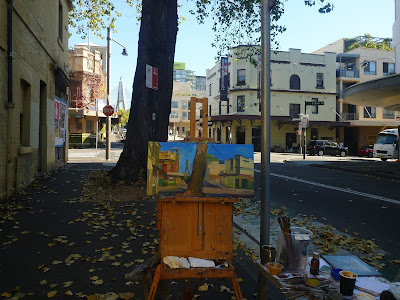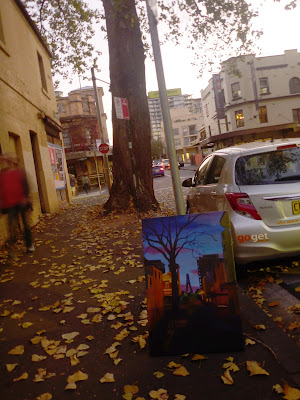"The Mother Art is Architecture" is part of a quote by Frank Lloyd Wright.
The full quotation is : "The Mother Art is Architecture. Without an Architecture of our own we have no soul of our own civilization".
I am one of 6 artists, John Waters, Isabelle Devos, Jane Bennett, Stephen Nova, Chris Brown,
and Hadyn Wilson currently exhibiting in the group show "The Mother Art is Architecture" at FrancesKeevil Gallery, 28-34 Cross Street Double Bay. Architecture is the theme; yet each artist takes it in quite different directions.Almost everything that I have ever painted has either been demolished or changed beyond all recognition: the pubs have been gentrified, working class terraces are now apartment blocks and Sydney is no longer a Working Harbour.
I have spent most of my career painting the loss of Sydney's "soul of civilization".
Without an architecture of our own we have no soul of our own civilization.
Read more at: http://www.brainyquote.com/quotes/quotes/f/franklloyd127711.html
Read more at: http://www.brainyquote.com/quotes/quotes/f/franklloyd127711.html
Without an architecture of our own we have no soul of our own civilization.
Read more at: http://www.brainyquote.com/quotes/quotes/f/franklloyd127711.html
Read more at: http://www.brainyquote.com/quotes/quotes/f/franklloyd127711.html
I was "Artist in Residence" at the
"Hungry Mile", East Darling Harbour Wharves during its last years as
a working port, courtesy of Patrick Stevedores and Sydney Ports Corporation. When I knew that port operations were ending, I
used the wharf itself as a studio and gained unprecedented access to every
aspect of the activities there. I painted on the wharves, from the bridge of the
ships (courtesy of the ship’s captains) and wonderful
bird’s eye views from the top of Harbour Control Tower. After the last ship had sailed, I continued my
epic series of paintings of Barangaroo, the largest and most controversial
Sydney Harbour construction project in living memory.
I
had the run of the top floor and the amenities level of the 87 metre high
Harbour Control Tower from the early 2000s until port operations finished there
in April 2011, and afterwards had access to create paintings of various stages of the construction of Barangaroo. I spent many New Year’s Eves on the top floor, painting 360
degrees of the fireworks exploding underneath against the unforgettable harbour
view.
Two major works on paper which I painted from the top of the Harbour Control Tower a couple of years apart, will be featured in this exhibition.
These two large mixed media drawings show the maximum
possible contrast between old and new; between heritage and development;
between tradition and progress.
One shows views over Barangaroo and the waterfront. The
other looks out over Millers Point towards the bridge. A nod to the past - and
a look to the future.
The 2 works overlap slightly, sharing the
sweeping curve of the workers terraces of High Street as well as the quirky
asymmetry of the old Palisade Hotel in common. They are on the far left
hand side of the earlier work, and on the far right hand side of the later
work.
 | |
| HCT34 'Millers Point and Barangaroo from the top of Harbour Tower' 2010 ink acrylic gouache on paper 102 x 125cm Enquiries |
By the time of painting the later work, the
Palisade had nearly completed its transformation from a down at heel wharfies’
dive into a luxurious upmarket watering hole for the new residents of Barangaroo and Walsh Bay Wharves.
The earliest version of the Palisade was built in the
late 1800s, but the Sydney Harbour Trust commissioned Henry Deane Walsh to
build a hotel on top of the pub, which was completed in 1915. The Palisade
Hotel was literally a landmark as it was the highest building in Sydney at the
time. Many diggers sank their last beer at the hotel before they boarded ships
bound for the First and Second World War. It was also used as a lodge for
workers constructing the Sydney Harbour Bridge. Over the years, the hotel has
been frequented by many “colourful characters”. There's
almost too much history in the walls.
Atop Millers Point, high above the harbour, the old
Palisade Hotel sat forlorn for 7 years from the end of World Youth Day in
2008 until its reopening in August 2015, just in time for its centenary.
It had been closed in 2008 for an renovation by the then owner and sold at auction
in March 2015 for about $20 million. Now the new owners have given it a $5 million
renovation and reopened the ground-floor public bar.
This large mixed media drawing shows the view
looking south from the Harbour Tower. The wharf buildings have just been
cleared, revealing a bare expanse of concrete with a few cryptic markings which
could either be for vehicles or possibly guidelines for future construction.
The white marquee in the centre right of the wharf is the temporary cruise ship
terminal. Soon afterwards, it was removed when the new cruise ship terminal at
White Bay was opened.
A faint shadow of the Harbour Tower is cast over a section of the wharf, about to be excavated for the Barangaroo Headland Park, which opened a year ago
in August 2015.
The left hand side shows the early 20th
century Federation heritage architecture of Millers Point, still at this stage
inhabited by the descendants of 5 generations of waterside workers. The staggered walls and gables that serrate the roofline
of High Street are groupings of 4 individual flats, rather than individual
houses.
Upper flats were divided from lower flats by an
ingenious use of panels, to lessen noise and the risk of the spread of fire.
Each flat had its own ventilated laundry, bathroom and scullery at the rear
to maintain hygienic living conditions.
The
lower flats had a courtyard to dry clothes and access to a rear lane for
rubbish collection. The upper flats had rooftop drying platforms made of solid
hardwood beams, packed tightly side by side and bonded by steel rods. The washing
was launched into the air by nifty pulley mechanisms. Brick chutes and
concrete tubes allowed rubbish to be dropped to the lane below.
These humble dwellings were actually cutting edge design
solutions to the problems of medium density urban living. They pioneered some of the
earliest use of now ubiquitous technology in Sydney housing and incorporate some of the aesthetics and principles of Frank Lloyd Wright, who believed buildings should be made from the land and benefit the environment.
Another famous quote by Frank Lloyd Wright can be used to contrast the modest utility of the workers flats with the pomposity of recent development at Barangaroo : "A building should appear to grow easily from its site and be
shaped to harmonize with its surroundings if Nature is manifest there.”
 |
| HCT42 'Vale Millers Point' 2014 ink acrylic gouache on paper 106 x 136cm Enquiries |
This
mixed media drawing was one of the last I was able to paint from the top of
the Harbour Tower.
It's the quintessential Sydney Harbour view,
with a breathtaking panorama of Walsh Bay Wharves and
Millers Point below my
feet, and
the Sydney Harbour Bridge in the background.
I have painted every single building in this canvas from ground level, often
from several angles, and met most of the residents and
workers, old and
new.
 |
| Detail of protest banners in High Street - HCT42 'Vale Millers Point' 2014 ink , gouache on paper 106 x 136cm Enquiries |
The
heritage architecture of Millers Point is festooned with a few defiant
banners protesting against the inevitable eviction of the residents of High
Street, Windmill Street, Lower Fort Street and Dalgety Terrace.
Reg Mombassa designed a T-shirt with the logo of a skull smoking a cigar and wearing a top hat, symbolizing the real estate agents and developers now infesting the once sleepy backwater.
A few hang from the rooftop drying platforms in Dalgety Terrace.
 |
| Close up detail of protest T Shirts in Dalgety Terrace HCT42 'Vale Millers Point' 2014 ink acrylic gouache on paper 106 x 136cm |
At
the time of painting, the Palisade Hotel was soon to be re- opened after 7 years
of emptiness. In contrast, the city and
Walsh Bay Wharves remain shrouded in
darkness.
In the background, cranes pick at the skeleton of the half demolished
Hammerhead Crane on Garden Island.
Earlier that year I had braved the daunting
bureaucracy of the Navy to become the ‘Artist in Residence’ on Garden Island
for several months so that I was able to paint the last days of this historic
naval relic before it was demolished.
While
painting this work, I realized the Harbour Control Tower was under
threat of demolition, despite being an iconic landmark.
The
demolition process began in March 2016 and
will continue until the end of the
year.
Another quote from Frank Lloyd Wright :
“Architecture is life, or at least it is life itself taking form and therefore it is the truest record of life as it was lived in the world yesterday, as it is lived today or ever will be lived.”



















